 |
First real snowfall of December saw 7.3" fall in one day.
photo by Sara K Joiner
|
This year is the first year we're celebrating Christmas in our new home. While I was living here last year, I was alone and had only started my new job four days earlier. It even snowed this past weekend to give us a extra-special Christmas feeling and set the stage for December 25.
But it's not the first white Christmas I've experienced.
In 2004, it snowed along the Texas Gulf Coast on Christmas Eve and the wee hours of Christmas Day. The Miracle Snow some people called it. The strangest thing about that snow was that areas closer to the beach received more snow than places farther inland. At my apartment we probably had four or five inches!
I heard stories from people waking up their children in the middle of the night to go play in the snow. It's so rare to see that much snow in Texas that it truly is astonishing. People still talk about the Christmas Snow of 2004. There was even a book published.
Now I live up north and snow has lost a little of its appeal, especially after having to shovel it for the first time ever. A snow thrower soon became my most desired Christmas gift.
But it sure is nice to sit inside with a cup of hot chocolate and watch it fall so silent and peaceful.








